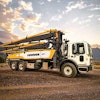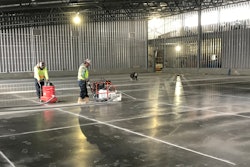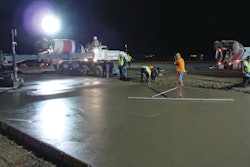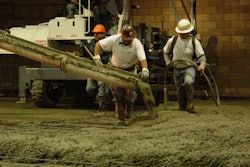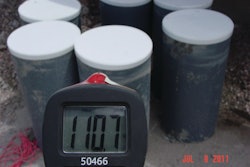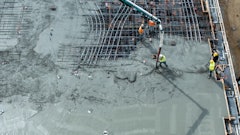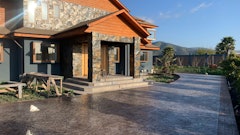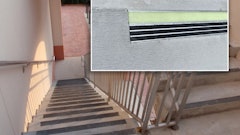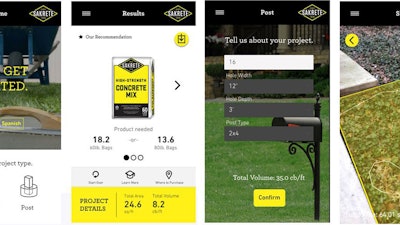
Working with concrete can create a bit of anxiety, no matter how big or small the job—whether you're placing a slab, leveling out a space for a patio or setting posts. The first and most important step for any concrete project is to work out the volume of concrete needed – which isn't always easy, even for pros who are used to working in cubic yards.
To make it easy, Sakrete developed a new Sakrete App that eliminates the guesswork and helps keep the project on track from start to finish.
Dirk Tharpe, Sakrete's go-to concrete expert affectionately known as the Carolinas' Concrete Cowboy, says, "While there is nothing wrong with traditional estimation, it's definitely not something most of us can do in our heads. Plus, not all jobs are easy rectangles. Adding concrete footings to posts or laying an irregularly shaped or curved slab can require meticulous measuring, or make you dust off your old geometry book, and that can slow you down…but as they say, we have an app for that."
Estimating Capabilities
Tharpe describes Sakrete's free app as not just a measuring tool, but a total volumetric job estimator. Ideal for novice DIYers or seasoned pros, the app features simple point-and-shoot estimates on a smart phone without the hassle of tedious calculations.
Estimating the necessary volume of concrete with the app is very intuitive. Start by choosing a project type, then enter the project's dimensions using the app's Augmented Reality (AR) function to scan the area to receive the recommended Sakrete product, quantity and where to buy it locally. It can even estimate curves and irregular shapes with ease, simply by tapping the screen to place pins along the perimeter of the project area. The app also includes a tutorial for new users.
Free and available in English and Spanish, the Sakrete app can be downloaded for iOS and Android on the following devices: iPhone 6S or newer, iPad Pro (9.7", 10.5", and 12.9"), iPad 2017, or newer and Android devices running Android 7.0. Download at an app store or at http://www.sakrete.com/app
"Using AR spatial technology to measure and scan project sites, the app can quickly calculate the number of concrete bags needed for slab or post projects," says Tharpe. "It's an easy way to save time, money and material."
He added that whether a contractor or DIYer does the math or uses the app for more complex jobs, estimating concrete jobs accurately will give all parties a more accurate budget for material costing as well as save on headaches like those time-wasting trips back to the lumberyard for another bag or two when you come up short.
Rules of Thumb
Tharpe, who handles sales and training for Sakrete, Oldcastle APG's brand of time-saving, pre-blended, bagged building materials and concrete, says you can also estimate bagged concrete in other ways. His rule of thumb: one pallet containing 42 bags of 80-pound Sakrete High-Strength Concrete Mix is about a cubic yard of concrete. Though it actually takes 45 bags of 80-pound mix to hit a cubic yard dead on, this is a great method to get a good initial estimate.
Visualizing how far a cubic yard goes isn't always intuitive either, but Tharpe has a solution.
"Think of a 9' x 9' slab at 4" deep, or about five sidewalk squares," says Tharpe. In other words, 1 cubic yard of concrete placed at 4 in. deep will cover 81 square feet.
Alternately, one pallet of 56, 60-pound bags of Sakrete mix is also close to one cubic yard of concrete. Again, it actually takes 4 additional bags of 60-pound mix to equal a full cubic yard but this is a helpful estimating process.
The formula for estimating the volume of concrete in cubic yards needed on a project is straight forward, though it will definitely require a calculator.
Simply multiply the length by the width by the depth of the desired slab in inches, then divide by 1728. The result is the total cubic feet of the slab. To get to cubic yards, divide that number by 27. It's also a good idea to add ten percent to adjust for variations and waste to get your final number. See Tharpe's YouTube on Estimating Concrete.
Another shortcut method requires knowing a little bit about how far a single bag of concrete will go. The trick: for each foot of concrete, you'll need 1 50# bag, .8 60# bags or .6 80# bags. Though this method only works with a 4" slab, it's a single calculation that also automatically works in the 10% waste factor, making it a great standby.
For example, if you have a 9' x 9' slab at 4" deep, you have a total of 81 feet. If you're using 80# bags, you multiply the total feet (81) by the .6 bags per foot trick to get 48.6 bags – a bit on the high side, but in concrete it's always better to be safe than sorry.


